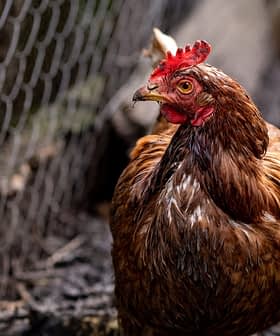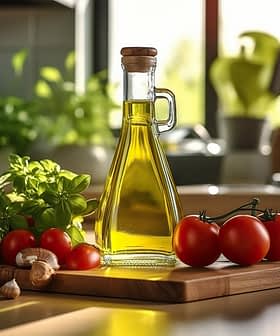Olive Oil Commission of California Funds Research
The OOCC's research projects for the new fiscal year will give the state's producers insight into the control of olive knot and olive anthracnose.
 The OOCC will provide nearly $15,000 of funding to research olive anthracnose. Photo courtesy of Valmir Duarte
The OOCC will provide nearly $15,000 of funding to research olive anthracnose. Photo courtesy of Valmir DuarteThe Olive Oil Commission of California (OOCC) has set aside $170,250 for research and related initiatives for the state’s olive oil sector in the 2019/20 fiscal year.
The majority of this funding from the OOCC, which was formed to support research for the California olive oil industry, will go to the UC Davis Olive Center, which is set to undertake many of the new research projects.
Anytime we can better understand issues that are affecting our quality and production, it is going to benefit all olive oil producers in California.
This includes $14,849 for research into olive anthracnose – a fungal disease that attacks olive fruit – in California and a $15,000 research project on the epidemiology and management of olive knot, which causes growths on olive trees.
“Olive knot is one of the most prevalent diseases for high and medium-density olives for oil,” Chris Zanobini, the executive director of the OOCC, told Olive Oil Times. “If we can effectively minimize the spread or the presence of the disease, as well as have effective tools to combat it, we can ensure the future growth of high-quality olive oil from California.”
See Also:California Olive Oil News“Anytime we can better understand issues that are affecting our quality and production, it is going to benefit all olive oil producers in California,” he added.
OOCC research coordinator Tyler Rood said olive knot is one of the most economically significant diseases for olive growers in the state.
“Infection may lead to tree defoliation, dieback and reduced tree vigor, which ultimately lowers fruit yield and quality,” Rood told Olive Oil Times
He added that the OOCC and California Olive Committee (COC) are jointly funding a separate project to provide olive growers with the knowledge and tools to combat the disease.
Jim Adaskaveg, a plant pathologist at UC Riverside who has investigated the epidemiology of olive knot, is now using this knowledge to develop and promote integrated management strategies for the control of the disease in California.
Rood said Adaskaveg has shown that olive knot is caused by an opportunistic pathogen, Pseudomonas savastanoi pv. Savastanoi, which is more prevalent in damp conditions and “can infect olive [trees] through wounds caused by mechanical injuries from pruning and harvest.”
To reduce the rate of new infections, Adaskaveg promotes the pruning and removal of wood infected with olive knot during dry periods, as well as the sanitization of pruning and harvest equipment following exposure to olive knot.
“Jim has gone so far as to evaluate new sanitation materials,” Rood said. “Namely quaternary ammonium.”
He added that quaternary ammonium is highly effective for sanitizing pruning and harvesting equipment, and is non-corrosive.
Rood said copper-based bactericides, which are widely used in both conventional and organic agriculture, is the only available and effective foliage treatment for the control of olive knot.
Adaskaveg also evaluates the effectiveness of copper alternatives aimed at reducing dependence on the metal and preventing widespread Pseudomonas savastanoi pv. Savastanoi resistant to copper. He will present his annual findings at California Olive Oil Day, which is funded by the OOCC, on March 5, 2020.
Meanwhile, the OOCC research project on the occurrence and distribution of olive anthracnose in California is led by Florent Trouillas, assistant cooperative extension specialist at the UC Davis plant pathology department.
Rood said this project aims to identify which species of Colletotrichum fungus are associated with olive anthracnose in California, and if these species cause disease to the main cultivars found in the Golden State.
He said symptoms resembling olive anthracnose have recently been identified in olive orchards in the Sacramento Valley.
“While strains of Colletotrichum are known to cause olive anthracnose throughout the world and disease of other commodities found within California,” Rood said. “The occurrence of olive anthracnose in California remains unknown.”
“Given that olive anthracnose poses a threat to olive orchards worldwide, and negatively impacts yields and quality of olive oils made from affected fruit, it is important that we as an industry act and determine the occurrence and distribution of olive anthracnose in California,” he added. “Documenting the occurrence and distribution of the disease in California will allow the industry to begin developing management protocols and registering new materials for control of the disease.”
“Should Colletotrichum not be isolated and identified from symptomatic tissues sampled from surveyed oil olive orchards,” Rood further explained, “Florent will identify and record which pathogens are causing the symptoms observed in orchards. These efforts will help the industry to record the geographical and seasonal occurrence of diseases of oil olives within the Central Valley.”
Another research project funded by the OOCC for the 2019/20 fiscal year is a $30,000 project to update the olive production manual. In addition, the OOCC is funding a $6,500 project to identify areas of irrigation management in California that lack sufficient research.
They are also funding a $7,500 research project on peacock spot – jointly funded with the COC – and a $10,000 project on the nutritional needs of olive orchards.
Additionally, the OOCC is investing $7,500 to compile a database to ensure their purity standards are in line with the characteristics of extra virgin olive oils produced in the state; $42,850 for a survey of the quality of California olive oil; and $11,250 to evaluate the impact of the OOCC’s mandatory sampling and testing on the quality of the state’s olive oil.
Besides these research projects, the OOCC funds California Olive Oil Day, which was launched two years ago and gives growers the opportunity to interact with researchers at the Olive Center.








